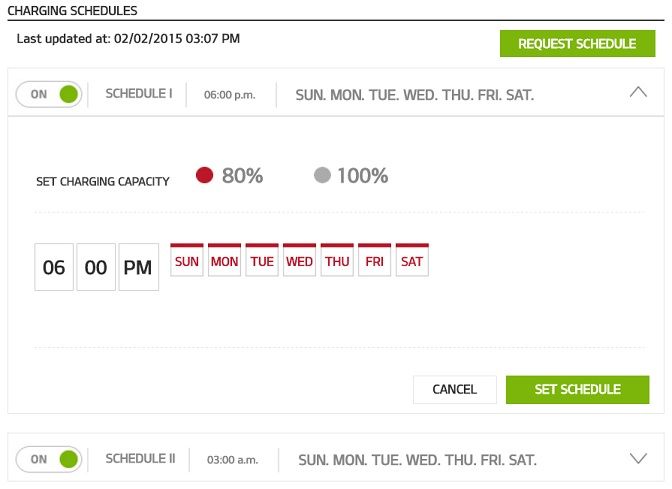cdub
OG 2011 Leaf / 2023 Model Y LR
After my experience with the leaf I won't buy an EV without an amazing battery. 40% loss and still considered normal under warranty? No thank you.
You can install our site as a web app on your iOS device by utilizing the Add to Home Screen feature in Safari. Please see this thread for more details on this.
Note: This feature may not be available in some browsers.
The Volt has had exactly 0 batteries replaced under warranty *due to degradation issues*. I have faith that the Bolt's battery won't actually degrade 40%....or even anywhere close to that number.
I mean forget warranty replacement, there are still no verified cases of owners experiencing ANY kind of noticeable degradation in their Volts!
EPA deserves some blame here for their policy of averaging daily vs 100% charge ranges for the window sticker range. That caused Nissan and now GM to default to "100%" charge and not have a clearly documented daily charge setting. Dumb.
Obviously Nissan and GM should really have a slider like Tesla to get around this EPA issue and to allow owners to set charge levels that make the most sense for them. It's a mystery why they don't have sliders. Does anyone else besides Tesla?
Personally, I'd like to charge to the nominal battery level of 75% which would leave my battery at around 55% when I get into work which would be a nearly ideal level for sitting around all day unplugged.
There is a hidden daily charge mechanism on the Bolt EV called "Hill Reserve" that pretends to be about allowing room in the battery for downhill regenerative braking. It causes charging to stop at 90% usable. The 100% usable is probably around 95% nominal since beyond that point calendar aging typically speeds up a lot on similar Lithium ion batteries. Therefore, Hill Reserve will result in an 85-86% nominal charge which is about how high the Chevy Volt plugin hybrid charges.
Well it's only about 5 years down the road and the 30% qualifier is pretty lax, so it's no surprise if there have not been any claims yet. Also it's relatively difficult to determine degradation in the Volt from a combination of it not making things very visible (given it's a PHEV using only the middle of the pack) and also from it having relatively short AER compared to an EV (a loss of 10% is only 3-4 miles of range and would not be as noticeable).The Volt has had exactly 0 batteries replaced under warranty *due to degradation issues*. I have faith that the Bolt's battery won't actually degrade 40%....or even anywhere close to that number.
I mean forget warranty replacement, there are still no verified cases of owners experiencing ANY kind of noticeable degradation in their Volts!
EPA deserves some blame here for their policy of averaging daily vs 100% charge ranges for the window sticker range. That caused Nissan and now GM to default to "100%" charge and not have a clearly documented daily charge setting. Dumb.
Obviously Nissan and GM should really have a slider like Tesla to get around this EPA issue and to allow owners to set charge levels that make the most sense for them. It's a mystery why they don't have sliders. Does anyone else besides Tesla?
Personally, I'd like to charge to the nominal battery level of 75% which would leave my battery at around 55% when I get into work which would be a nearly ideal level for sitting around all day unplugged.
There is a hidden daily charge mechanism on the Bolt EV called "Hill Reserve" that pretends to be about allowing room in the battery for downhill regenerative braking. It causes charging to stop at 90% usable. The 100% usable is probably around 95% nominal since beyond that point calendar aging typically speeds up a lot on similar Lithium ion batteries. Therefore, Hill Reserve will result in an 85-86% nominal charge which is about how high the Chevy Volt plugin hybrid charges.
That's what I said. The Bolt is great for commuting but not for trips.It always bugs me that people seem to think that there is commuting and road trips, and nothing in between. In 4 years of owning my Model S I've used superchargers twice. However, the car is perfect for day trips and weekend trips, which a shorter range EV wouldn't be. There is an enormous difference between the capability of an 80 mile EV and a 200 mile EV. Besides which, talking about going from completely empty to completely full is not how one would want to charge anyway. In a Model S it takes at least an hour and a quarter for the same thing.
Obviously Nissan and GM should really have a slider like Tesla to get around this EPA issue and to allow owners to set charge levels that make the most sense for them. It's a mystery why they don't have sliders. Does anyone else besides Tesla?

If this thing (JuicePlug - an $89 Universal Smart EV Charging Adapter) ever ships, people will have an easy way to restrict charging to whatever % they feel like, without having to toy with charge settings/hill top reserve or whatever.
edit: crap, I just realized the Juiceplug probably doesn't allow you to set a certain % to shut off charging. Should have read the fine print before contributing to the kickstarter. Whoops.
Well, still will be good to have live access via the smartphone app and kWh usage stats!
Per the manual (p.129); I added the underlining.Don't ask me where they got 40% from.....maybe if you're leaving on an extended trip and don't want to leave the HV battery at a high SOC?
The Volt also had/has a HUGE buffer...which the Bolt does not.
4.3 kWh divided between top and bottom.
Larger than some perhaps, but HUGE is a bit of stretch.
I'd say compared to the Bolt, it's HUGE.
A) How many kWh is the Bolt's buffer?
B) The Volt has a nominal 18.4kWh array. How much of it is used? 4.3 kWh's is buffered but it is not a dead buffer like on an EV. It is constantly used.
Unlike some EV's when you "100%" charge a Volt, it can regen at 60kWh immediately.
And? The Volt has a 75kW generator on board and a 120kW AC traction motor assy. When you consume all of the 14.1 kWh working window, the gas generator comes on. The Volt still has 120kW of drivetrain output, even though the 75kW motor cannot produce it. It is using battery buffer to augment the generator output.
I have no idea what the unused buffer area is on a Volt. Best guess? 2 kWh.
A) How many kWh is the Bolt's buffer?
B) The Volt has a nominal 18.4kWh array. How much of it is used? 4.3 kWh's is buffered but it is not a dead buffer like on an EV. It is constantly used.
Unlike some EV's when you "100%" charge a Volt, it can regen at 60kWh immediately.
And? The Volt has a 75kW generator on board and a 120kW AC traction motor assy. When you consume all of the 14.1 kWh working window, the gas generator comes on. The Volt still has 120kW of drivetrain output, even though the 75kW motor cannot produce it. It is using battery buffer to augment the generator output.
I have no idea what the unused buffer area is on a Volt. Best guess? 2 kWh.
After my experience with the leaf I won't buy an EV without an amazing battery. 40% loss and still considered normal under warranty? No thank you.
Note. Nissan has never made good cars. They tend to make junk. They tried to screw us twice on major failures under warranty. They failed both times than that dealership is now gone.
I charged to 80% almost all the time and it still happened for me. I charge to 100% now... Otherwise I can't make it back home from work. 36 miles round trip! Can't wait until the new battery is ready for me. They're paying for 2/3s of the cost of the replacement.A friend of mine had a Sentra that liked to eat engines. For emissions control, they had Pre-Cats up in the exhaust headers - and EGR was accomplished by late valve opening. Somewhat predictably, the pre-cats would break down from the vibration and thermal cycling and the particles would be sucked back into the cylinders. Nissan replaced the first engine under warranty - he traded the car abruptly when the second engine was starting to go for a Subaru.
Having said that, everything I've read suggests the Leaf is actually a pretty solid car - except for the battery degradation problem, which would likely be much less of an issue if they were routinely charged to 80% as I suspect Nissan was expecting before the EPA rules change (none of which excuses Nissan's decisions or responses, but it does somewhat explain them I believe.)



